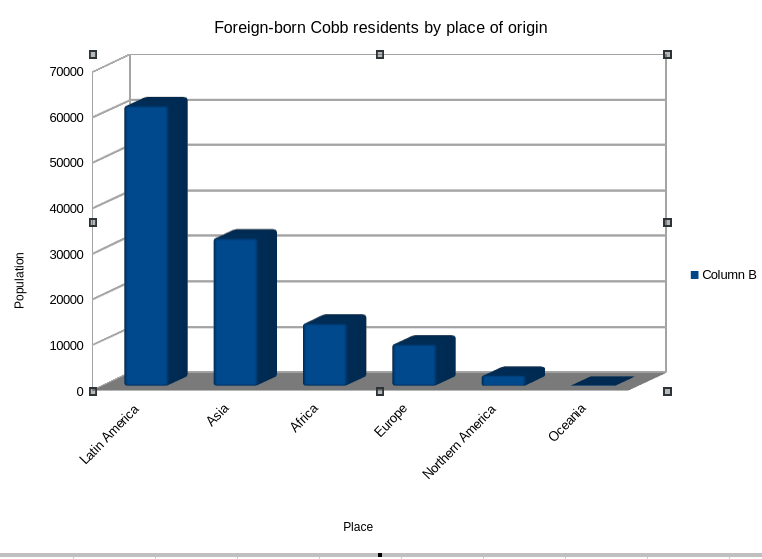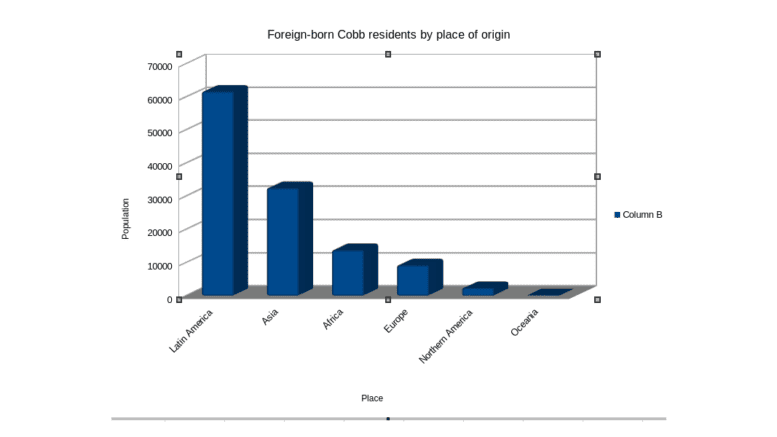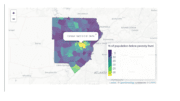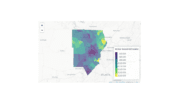The Courier is publishing a series of articles springing from the 5-year American Community Survey (ACS) released last Thursday by the U.S. Census Bureau (more on that below). We think it’s important that engaged and active citizens have an accurate picture of the nature of our changing county, its economy, demographics, and dozens of other factors that are included in the ACS.
This is the second article in that series. Our first article was What percentage of Cobb County residents are living in poverty?.
The reason we chose these as our first topics is that they were featured in the U.S. Census Bureau’s first press release about the release of the 5-year ACS. We took the table the press release used for the national figures, and filtered them to get the equivalent data for Cobb County.
To answer the question posed in the headline: 119, 544 residents of Cobb County were born outside the United States, out of a total of 765,813.
In other, words 15.6 percent of residents of Cobb County were born outside the U.S. Of those foreign-born residents: 48.3 percent have become naturalized U.S. Citizens, 51.7 percent are non-U.S. Citizens. (Be sure not to conflate non-citizenship with immigration status. There are many legally resident foreign-born visitors, including those on work or student visas).
During the 2018-2022 period covered in the 5-year ACS, there were an estimated 45.3 million foreign-born people in the United States; 13.7% of the nation’s total population. So Cobb County has a foreign-born population 2 percentage points higher than the nation as a whole.
Those figures come from census table DP02: Selected Social Characteristics in the United States. You can look at the table for Cobb County by following this link.
Here are the places of origin of foreign-born residents of Cobb County, and their approximate numbers and percentage of the overall foreign-born population:
| Europe | 9180 | 7.7% |
| Asia | 32497 | 27.2% |
| Africa | 13767 | 11.5% |
| Oceania | 159 | 0.1% |
| Latin America | 61617 | 51.5% |
| Northern America | 2324 | 1.9% |

Don’t confuse place of birth with race or ethnicity. Let’s take, for instance, the row “Latin America.” There are an estimated 61,617 foreign-born people who arrived here from Latin America.
But the ACS estimates, in the table you can view by following this link, that the Hispanic or Latino population of Cobb County is 103,006 (13.5 percent of the county’s population). The figure for the Hispanic or Latino population includes both native-born and foreign-born people who identify as Hispanic or Latino.
About the American Community Survey
December 9, 2023 was a big day for people who follow the census. The 5-year American Community Survey (ACS) for 2018 to 2022 was released.
A short version of the difference between the decennial census and the ACS is: the better-known decennial census attempts to count the entire nation every ten years, but asks a lot fewer questions. The ACS polls a lot fewer people but with a lot more questions and is done yearly and then grouped into 1-year- and 5-year versions.
The ACS is conducted yearly, and grouped into two categories: 1-year ACS, and a “rolling” 5-year ACS. “Rolling” means that there is overlap in the 5-year ACS released from year to year. So there were releases for 2016-2020, 2017-2021, 2018-2022, etc. each representing 5-year blocks. The Census recommends that if you want to compare the current numbers with past numbers, you use non-overlapping surveys.
For example, what if I want to know what the trend is for a particular topic over the most recent changes?
The best surveys to compare would be 2013-2017 and 2018-2022.
Both the decennial census and the ACS are important.
The Decennial Census determines how many representatives each state gets in the House of Representatives.
The ACS has an enormous amount of data not on the 2020 Decennial Census, such as education, employment, internet access, and transportation, and is used by federal, state and local governments, businesses and policy advocates to make decisions about where to place their efforts.
Further, there are advantages and disadvantages to the 1-year versus the 5-year ACS. The one-year version is more current, but the 5-year version is believed by the Census Bureau to be more accurate.





